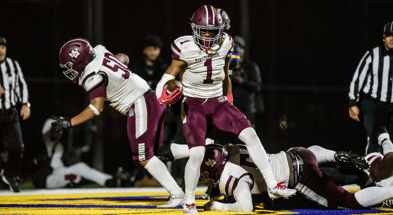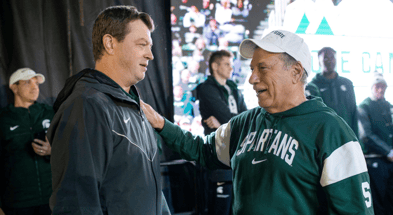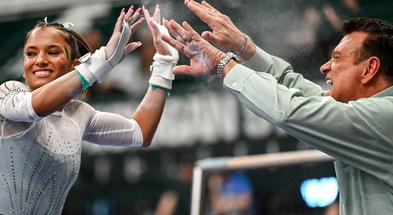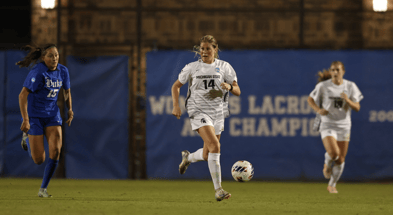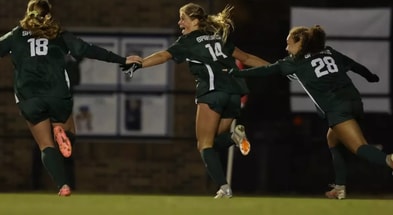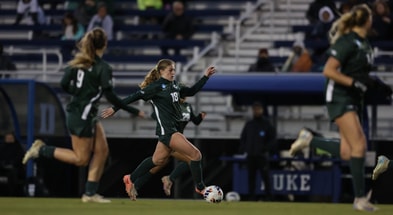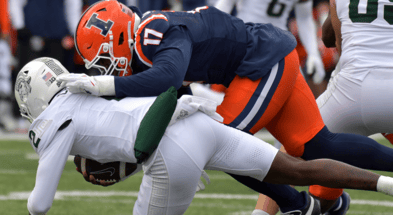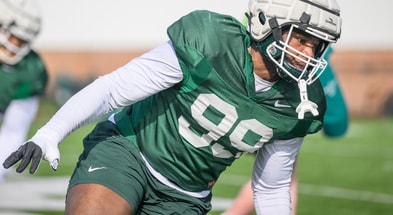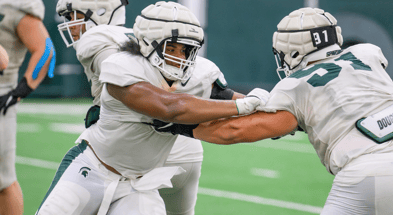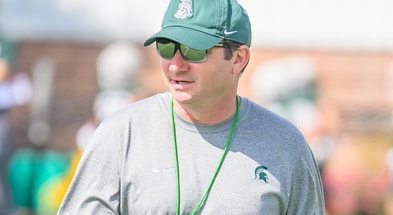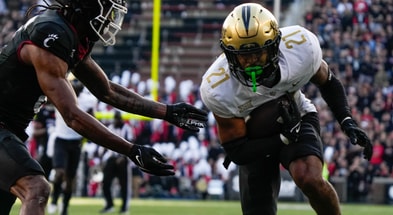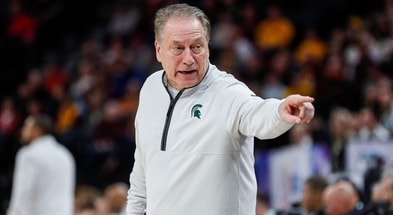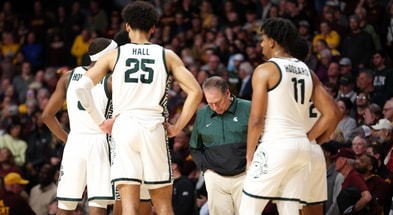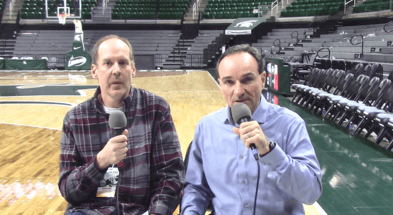3-2-1: 'The challenge is real' for surging Michigan State women's basketball

EAST LANSING, Mich. – It’s fair to say that the Michigan State women’s basketball team snuck up on a few of their opponents last season.
With a first-year coach in Robyn Fralick and a lineup that was diminished with season-ending injuries, not much was expected of Michigan State in 2023-24.
As a matter of fact, the Spartans were picked to finish 10th in the Big Ten in an unofficial poll.
But Michigan State bucked all trends with a 22-9 finish and an NCAA Tournament bid.
This season, after losing two of its top four scorers – shooting guard Moira Joiner to graduation and point guard DeeDee Hagemann to the transfer portal – the Spartans were looking to retool with four transfer portal additions of their own and four incoming freshmen.
The biggest and best of those additions is junior forward Grace VanSlooten, a Toledo native who transferred to Michigan State after two honorable mention All-PAC 12 seasons at Oregon. She averaged 14.1 points and 6.4 rebounds over two years with the Ducks.
The Spartans also returned 6-foot-2 graduate guard/forward Julia Ayrault, who earned first team All-Big Ten honors after leading Michigan State in scoring at 15.4 points and 7.3 rebounds a game, and 5-10 junior guard Theryn Hallock, who earned Sixth Player of the Year accolades after coming off the bench last season to finish fourth on the team in scoring at 11.2 points per game.
The Spartans played an exhibition contest against Wayne State on Oct. 28, winning easily 101-40, putting six players into double figures.
While the game against the Division II Warriors was no real measure, the team’s 107-42 crushing of Oakland University to open the season on Nov. 5, followed by an equally impressive performance against Yale on Friday night, during which Michigan State hit the century mark once again, winning 100-44, was a message sent as to how this team will play and what opponents and fans can expect to see going forward this season.
Michigan State will look to continue its early season dominance by welcoming Eastern Michigan at 6:30 p.m., Monday at Breslin Center (BigTen+).
Continue below for Three Things We Learned, Two Questions, and One Prediction based on what we’ve heard and seen so far from Michigan State’s women’s basketball team.
THREE THINGS WE LEARNED
1. No Dee Dee, No Problem?
When Hagemann’s 12.3 points and 5.2 assists at the point guard position departed East Lansing via the transfer portal – Hagemann ended up at Memphis – there was a worry that Michigan State might be in trouble in terms of who would run the offense going forward into the 2024-25 season.
No worries.
With Hallock set to step in, plus an additions from the transfer portal, Fralick believes the Spartans will be just fine at the point.
Hallock, who provided 11.2 points and 2.6 assists per contest last season, will obviously need to increase her assist numbers but she will have some help from portal additions Nyla Hampton and Jaddan Simmons.
Hampton is a 5-foot-7 graduate student who played at Bowling Green and Ball State, while the 5-9 Simmons, also a graduate student, comes in from Arizona State.
Hampton provided 4.8 assists a contest for the Cardinals last season, while Simmons averaged 3.4 assists per game in 2023-24 for the Sun Devils.
Fralick believes that will be enough to compensate for the loss of Hagemann.
“We have a few players who can play that spot, so I think right now we’re figuring that out. Theryn (Hallock) has played that (spot). She played that last year. Nyla Hampton (who) transferred (in), has played a ton of minutes (at the point),’’ Fralick said. “She played for us, at Bowling Green and (also played at it) Ball State, and then Jaddan Simmons also has played a lot of minutes at that spot. So we feel like we’ve got some versatility at that spot, and we’re and we also think those kids can play together at the same time too.’’
As the team’s primary ballhandlers, through two games, Hallock, Hampton and Simmons have combined for 28 assists and 10 turnovers.
2. The Long Game Continues
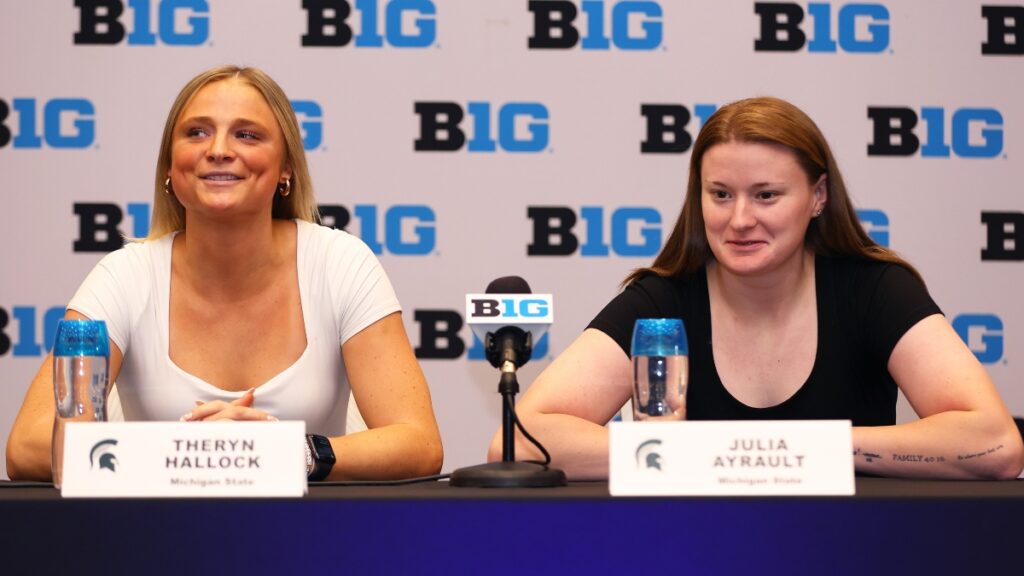
By now, everyone has become aware of Fralick’s desire to press and pressure the opponent into turnovers and easy buckets for Michigan State. Last season, that approach resulted in some disruptive problems for teams facing Michigan State and some beneficial results for the Spartans en route to their NCAA Tournament season.
Michigan State forced its opponents into 18.2 miscues per contest, resulting in 20.5 points off turnovers per game. Additionally, the Spartans’ pressure defense produced 9.2 steals per contest.
This season, with six players in the rotation who measure from 5-foot-10 to 6-3, the Spartans have enough versatility and length to take their pressure up another notch baseline to baseline.
That should translate into an even stronger Michigan State team in year two for Fralick. Right?
“Every year, the energy goes into more and more of the things that matter,” Fralick said. “In your first year, there’s just transitional energy. It’s as simple as, how do you turn on the copier, where’s the restaurant and how do you get to the practice gym? Everything’s new, and there’s a fun part to that too. It’s the same with the team but going into a second year, even from a relationship perspective, there’s just more time, more trust and more understanding of what we expect out of every day.’’
That length was on display in the first two games where Michigan State started lineups that measured 5-10, 5-10, 6-1, 6-2 and 6-3.
As a result, through eight quarters, Spartans have forced 64 turnovers and had 40 steals. Those numbers have led to a +20.5 in turnover margin. A trend Fralick expects to be the foundation of this team’s success throughout the season.
“When you force turnovers, you have advantage basketball, so you’re usually in a situation to create a really good shot,’’ Fralick said after Michigan State’s 65-point victory over Oakland. “I thought our team did a good job being disruptive, and our disruption led to a lot of advantages.’’
3. Going Deep With A Purpose
For three months last season, the Spartans played with a rotation of just seven players, out of necessity, due to injuries.
That made their run to the NCAA Tournament and their No. 4 seed in the Big Ten Conference Tournament even more remarkable in Fralick’s first season.
While the Spartans looked as though they may have run out of gas late in the season last year, they were able to accomplish some things that many didn’t think would be possible considering their roster numbers.
This season, unless they have a rash of injuries, depth will not be a problem.
Michigan State started the season with 14 healthy bodies, losing just one player for the season in redshirt junior forward Isaline Alexander with what is suspected to be a lower body injury.
While it is unlikely that all 14 will get significant playing time, the Spartans should have a strong rotation of nine to 10 players who can contribute quality minutes.
That means Michigan State should also be able to improve even more on their dedication to playing an uptempo defensive game, that is predicated on causing turnovers for easy baskets the other way.
“We played seven players last year, so we really played two players off the bench, but we did lead the Big Ten in bench scoring,’’ said Fralick with a smile. “So those two players off the bench were doing a lot.
“But from a depth perspective, depth is only an advantage if you use it, or else it’s confusing, or it’s hard or it’s just, who do you play tonight? So, our job is to figure out, how do we use depth as a competitive advantage? And with the way we like to play with different presses and different tempos and being disruptive defensively, playing with pace offensively and to do that well, you need for depth to matter. So that’s been something we’ve been really trying to train and also have our team understand. We have to have a mentality around ‘Earn your sub.’ It’s a good thing that we have another player that can go in and go at a high level.’’
Top 10
- 1Breaking
Shedeur Sanders not drafted
Slide continues
- 2
10 Best Available Players
After Rounds 1-3 of NFL Draft
- 3
Picks by Conference
SEC, Big Ten continue to dominate Draft
- 4Hot
Jalen Milroe
Drafted before Shedeur Sanders
- 5Trending
Shedeur Sanders
Reportedly pranked by fake NFL team
Get the On3 Top 10 to your inbox every morning
By clicking "Subscribe to Newsletter", I agree to On3's Privacy Notice, Terms, and use of my personal information described therein.
While the Spartans played every healthy player against Oakland, with no one playing over 20 minutes, they were able against Yale to play a rotation in the fourth quarter that required no minutes played by any of its starters.
TWO QUESTIONS
1. Where will Michigan State be by the time they visit UCLA and USC in mid-February. That trip could be the team’s toughest two-game stretch of the season.

With the addition of USC, UCLA, Washington and Oregon, the Big Ten has taken a step up in the national landscape in women’s basketball.
USC opened the season ranked No. 3, while UCLA comes in at No. 5.
The Big Ten opened the season with six teams ranked in the Top 25 and could have as many as seven by February.
With Ohio State, Maryland, Indiana and Nebraska as preseason Top 25 teams, Michigan State is going to have a tough time this season, especially when you consider the fact that they will add another Top 25 foe to their schedule when they face preseason No. 24-ranked Alabama in the West Palm Beach Classic on Dec. 20.
There’s not going to be very many easy outs during conference play when the schedule begins on Dec. 15 at home against Iowa.
The Spartans will be looking for the added depth and talent to make the difference as they look to follow up last season’s NCAA Tournament berth with a second straight one in 2024-25.
“Will it (the Big Ten) be as good as it’s ever been? We added four really good teams, two of them will be preseason Top 10 in the country. So the challenge is real,’’ Fralick said. “I think that we would all prefer to go through life with people having expectations around us. I don’t think I’ve ever wanted to do anything where nobody had any expectations for me. So it’s the same with our team. I think you earn expectations, and that’s the trajectory you want to be on.’’
Fralick said the focus will be on making its opponents as uncomfortable as possible for 40 minutes
“I think we’re physical,” she said. “I think defensively, we’ve been disruptive and made it hard to score, and then offensively we’ve done a good job of getting to the free throw line consistently. Those are things we like early and we’ll learn more as we keep going.’’
2. What impact will Oregon transfer Grace VanSlooten have for the Spartans?
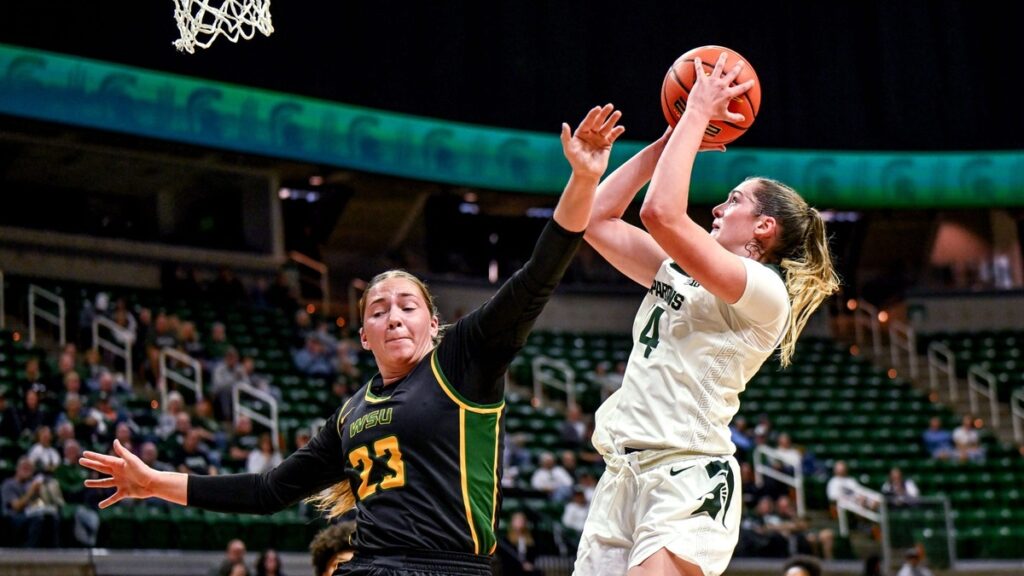
Grace VanSlooten, a junior, who was recently named to the Cheryl Miller Award Preseason Watch List, given to the nation’a top small forward in Division I, came to Michigan State after leading the Ducks in scoring, averaging 15 points and 7.1 rebounds per game last season.
She will need to replicate similar numbers for the Spartans in a lineup that needs to replace the point production provided by graduated guard Moira Joiner, who finished her last season at Michigan State averaging 14.7 points per game.
Through two games, VanSlooten has not disappointed. She is averaging 17 points and seven rebounds in just 18.4 minutes.
“(The addition of VanSlooten) it moves us around a little bit. It allows Julia (Ayrault) to play more of the four. It makes us bigger. I think we’re a lot longer defensively at the rim, being able to be disruptive, and it gives us another really good athlete on the court,’’ Fralick said. “Like, we’ll put Grace (VanSlooten) on the top of the press. We can move her onto different spots and she rebounds; and I thought (that was) something coming out of last season that we felt like could take us to another level, being a better rebounding team on both ends of the court.”
VanSlooten gives the Spartans a go-to player in the post in tough situations. Her ability to get to the free throw line will be a plus. Through two games, she is getting to the free throw line nearly nine times a game, while leading the team in scoring and rebounding.
She gives Michigan State the kind of presence and scoring punch they enjoyed during former Spartan and present WNBA performer Aeriel Powers’ time in East Lansing from 2013 to 2016.
“She’s physical,” Fralick said of VanSlooten. “She’s got good size (and) she’s got really good athleticism. When she gets the ball, she’s hard to keep in front (and) she’s hard to guard without fouling. I mean, she had 11 free throws and drew seven fouls (against Oakland). She just gives us a really physical presence inside.’’
ONE PREDICTION
1. Inés Sotelo will be the X-factor.

Inés Sotelo, a 6-foot-3 freshman center from Spain, comes in with all of the qualifications needed to step right into Division I women’s college basketball.
Although listed as a center, Sotelo’s skill set makes her a player who can excel best at the three or the four because she has that classic European game.
She can take you off the bounce, pick and pop for the 3 and she sees the floor well. As an added bonus, Sotelo is a very good defender who rebounds the basketball well on both ends of the court.
Although it was just an exhibition against a Division II opponent, in Michigan State’s 101-40 win against Wayne State, fans got a taste of what Sotelo brings to the court after she finished with 13 points on 6-of-8 shooting, with three steals, two blocks and two rebounds in just 15 minutes of play off the bench.
Sotelo came off the bench against Oakland to provide two points, with three assists and three rebounds in 15 minutes.
Once she gets fully adapted to the physicality and pace of the U.S. college game, she will be a valuable piece to the Spartans’ puzzle.
“Ines Sotelo was on the U-18 Spanish national team,” Fralick said. “So (she has) tons of experience. We love her defensive versatility. She can switch. She rebounds. She has a great feel for how to play.”

